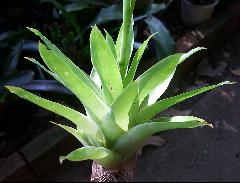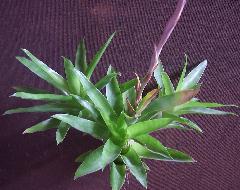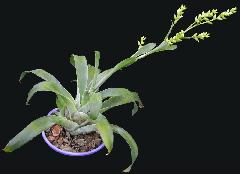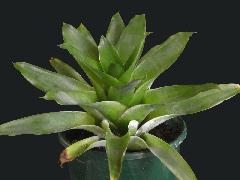






See notes on "Guatemala" below. |
Holotype: Hahn 587, Mexico, Jalapa, Veracruz,1865-1866; P? n.v.; isotype K!, staminate plant.
desc from Palaci 1997
Plants in flower (20) 25-40 (80) cm, dioecious, staminate plants usually smaller, but vegetatively similar to pistillate plants.
Leaves in a subfasciculate rosette, broadly lanceolate, (11) 20-30 (40) cm long, olivaceus green, with narrow yellowish margins, usually with abundant chalk-like epicuticular waxes especially towards the base;
leaf blades triangular to narrowly triangular, 1-2.5 cm wide, the apex long-attenuate, acuminate;
leaf sheaths indistinct, widely elliptic, (7) 10-15 (30) x (2) 4-7 cm, 1-4 times wider than the blades.
Scape erect or suberect;
scape bracts densely imbricate, the lower ones foliaceous, narrowly triangular, much longer than the internodes, the apex long-attenuate, acuminate.
Inflorescence erect, once or twice pinnate, 6-30 cm long, with 4-10 (22) spikes;
Iower primary bracts yellowish green, broadly ovate-lanceolate, the apex long- attenuate, acuminate, (2) 6-10 (14) x (1) 1.5-3 cm, much longer than the spikes, or very rarely ~ equalling the spike length;
spikes erect to spreading, short-stipitate, 3-5 (13)cm long, densely flowered, with ca. 6-12 (18) flowers per spike.
Flowers functionally unisexual, sessile.
Pistillate flowers:
floral bracts deltate, (5) 6-8 x 5-7 mm, 1-3 mm shorter than the sepals, chartaceous, faintly nerved, the apex obtuse, the margins narrowly hyaline;
sepals yellowish-green, asymmetric, elliptic to widely elliptic, 6-8 x 4-6.5 mm, chartaceous to subcoriaceous, smooth and faintly nerved, carinate, the apex obtuse;
petals white, triangular to narrowly triangular, 6-7 (8) x 4-6 (7) mm, slightly exceeding the sepals.
Staminate flowers:
floral bracts widely elliptic to deltate, (3.5) 5-7 x 4-6 mm, 1-2 mm shorter than the sepals, membranaceous, faintly nerved, the apex obtuse, the margins very narrowly hyaline;
sepals as in pistillate flowers, 5-7 x 4-6 mm;
petals white, 4.5-7 x 2-3 mm, slightly exceeding the sepals.
Capsules ovoid, short-beaked, 9.5-13 (15) x 4-7 mm.
Pine-oak forests, lower mountain forests and rain forests, 400-2700 m; s. Mexico, Belize, Guatemala, El Salvador, Honduras and Nicaragua.
Plants of C. hahnii are relatively variable in size; infrequent large plants are occasionally found in wet, undisturbed forests. The yellowish-green color of the inflorescence bracts and flowers makes this species of ornamental interest. Plants of C. hahnii are frequently sold in local markets in Guatemala city.
Material examined: see appendix.
Catopsis hahnii Baker, Jour. Bot. London 25: 175. 1887.
Catopsis oerstediana Mez, DC. Monogr. Phan. 9: 630. 1896. Type. Volcan El Viejo, Guanacaste, Costa Rica, Oersted 18 (C, F photo 22325).
Desc from S&D
Plant flowering over 5 dm high.
Leaves to 4 dm long, often bearing a slight cretaceous coat on the back;
sheaths elliptic, as long as or longer than the blades;
blades triangular, to 45 mm wide.
Scape erect or arching;
scape-bracts foliaceous, densely imbricate.
Inflorescence bipinnate or subtripinnate, narrow, 10-25 cm long, dense toward apex;
primary bracts nearly equaling to exceeding the lower branches, ovate-lanceolate, acuminate; spikes densely cylindric, to 45 mm long.
Floral bracts ovate-elliptic, obtuse, 6 mm long, shorter than the sepals;
flowers suberect, perfect (?) or unisexual.
Sepals asymmetric, 7-9 mm long, concolorous;
petals barely exceeding the sepals, white.
TYPE: Hahn 587 (holotype P), Jalapa, Vera Cruz, Mexico.
DISTRIBUTION. Epiphytic in forest, 1200-2700 m alt, southern Mexico, Central America. MEXICO. OAXACA: Talea, Galeotti 4919 (BR); Teotalcingo, Liebmann 42 (C); Portillo de Coyula, Cuicatlan, 10 Nov 1919, Conzatti 3870 (US). CHIAPAS: Saxchanal, Sierra Madre, 1 Jul 1941, Matuda 4319 (GH, LL, US); Monte Bello, Jan 1952, Carlson 2375 (US); Aug 1965, Roe & Mori 976 (US, WIS); 17 Aug 1966, Breedlove 14990 (US). GUATEMALA. QUICHE: San Pedro Jocopilas to Quiche, 12 Jan 1939, Standley 62464 (F); Nebaj, Rio de las Violetas Valley, 21 Jul 1964, Proctor 25201 (LL): HUEHUETENANGO: Aguacatan to Huehuetenango, 2 Jan 1941, Standley 81932 (F); 82014 (F); Mimanhuitz to Yulhuitz, Sierra de los Cuchumatanes, 14 Jul 1942, Steyermark 48624. (F); Xorlac to Nucapuxlac, 17 Ju1 1942, Steyermark 48917 (F, GH); Carrizal, 17 Aug 1942, Steyernzark 50823 (F, GH). ALTA VERAPAZ: Tactic, 14 Apr 1941, Standley 92353 (F); 92408 (F); 92638 (F); 20 Feb 1942, Steyermark 44013 (F). SAN MARCOS: San Marcos to San Rafael Pie de la Cuesta, 6 Feb 1941, Standley 86486 (F). CHIMALTENANGO: San Martin Jilotepeque to Chimaltenango, 3 Feb 1939, Standley 64502 (F). SOLOLA: Volcan Atitlan, 11 Jun 1942, Steyermark 47394 (F). HONDURAS. COMAYAGUA: El Achote, Siguatepeque, 21 Jul 1936, Yuncker, Dawson & Youse 6026 (GH). MORAZAN: Cerro de Uyuca, 7 Aug 1946, Williams & Molina 10268 (GH); 5 Dec 1946, Allen 4001 (MO); Standley & Williams 103-A (F, US); 15 Jul 1964, Molina 14558 (EAP, F, US). SALVADOR. SANTA ANA: Hacienda Montecristo, 7 Jun 1951, Rohweder 451-452 (HBG); Hacienda Los Planes, 453-463 (HBG); 25 Aug 1951, 464 (HBG). NICARAGUA. MATAGALPA: San Ramon to Bavaria Finca, 1963, Heller s n (F). JINOTEGA: Ocotillo, Santa Lastenia, 17 Jan 1965, Williams et al 27788 (EAP, F, US).
From Mez 1935
23. C. Oerstediana Mez in DC. Monogr. Phaner. IX. (1896) 630.
Paullo ultra 0,4.m alta. Folia multa, ad 0,15 m longa, super vaginam ad 45 mm lata inde in apicem angustata subtriangularia, haud cretacea. Scapus erectus, vaginis internodia longe superantibus involutus. Inflorescentia submultiflora, 2-pinnatim panniculata, densissime e spicis abbreviatis composita, subclavata, ad 0,11 m longa et 35mm diam. metiens; bracteis primariis inferioribus mediisque saltem ramulos axillares superantibus, omnino foliaceis et vaginis scapalibus isomorphis; ramulis stricte erectis, medium usque sterilibus tunc florum ad 7 spicam densissimam gerentibus; bracteis florigeris quam sepala permanifeste brevioribus, ovato-ellipticis, rotundatis, ad 6 mm longis. Flores (masculi ignoti) suberecti, ad 9mm longi; sepalis valde asymmetricis, quam petala brevioribus, posticis 2 obtuse carinatis, latissime ellipticis, rotundatis, subcoriaceis, ad 8 mm longis. Petala alba, sub-orbicularia. Stylus subnullus.
Costarica: Gipfel des Berges El Viejo (Oersted n. 18).
Protologue
Catopsis oerstediana Mez, DC. Monogr. Phan. 9: 630, 1896;
13, C. Oerstediana; foliis apicem versus sensim peracutis; scapo erecto vaginis internodia longe superantibus involuto; inflorescentia bipinnatim panniculata, bracteis primariis inferioribus mediisque saltem ramulos axillares superantibus, bracteolis florigeris quam sepala permanifeste brevioribus; floribus dioicis, male ignotis ; sepalis valde asymmetricis, quam petala brevioribus, stylo subnullo.
Florifera paullo ultra 0.4 m. alta. Folia 20-25, ad 0.25 m. longa, super vaginam ~ 45 rnm. lata inde in apicem angustata subtriangularia, haud cretacea. Inflorescentia submultiflora, densissime e spicis abbreviatis composita, subclavata, ~11 m. longa, 35 mm. diam. metiens; ramulis stricte erectis rnedium usque sterilibus tum florum ~7 spicam densissimam gerentibus, usque ad 45 mm. longis; bracteis primariis omnino foliaceis vaginisque scapaIibus isomorphis, suberectis; bracteolis florigeris chartaceis, glabris, dorso minute solum prominulo-venosis, ovato-ellipticis, apice optime rotundatis, ~6 mm. longis. Flores suberecti, ad 9 mm. longi; sepalis ex sicco luteis vel luteo-virentibus, subcoriaceis, dorso glabris laevibusque, posticis binis conspicue obtuse carinatis, latissime ellipticis, latere tecto in alam maximam, apieem obtusum longe superantem dilatatis, ~8 mm. longis. Petala alba, suborbicularia apice rotundata. Stamina in floribus female solum suppetentibus valde reducta antheris minutis, subsagitiformibus, hyalino-pellucidis, sterilibus. Ovarium in flore female maximum, crasse ovoideum.
Costariea in montis El Viejo regionibus summis: Oersted Brom. n. 18. (V. s. in herb. Haun.)
Moist lowland forests, 0-1400 m; Mexico, Belize, Guatemala, Honduras, Nicaragua, Costa Rica.
In flower from June to September,
Material examined: see appendix.
Catopsis morreniana Mez, DC. Mongr. Phan. 9: 628. 1896.
Catopsis bakeri Mez, Bull. Torrey Club 30: 435. 1903. Type. Volcan Mombacho, Granada, Nicaragua, C. F. Baker 2460 (B, B photo 1193/11), 20 Feb 1903.
Catopsis brevifolia Mez & Werckle ex Mez, Bull. Herb. Boiss. II. 4: 1127. 1904. Type. Without exact locality, Costa Rica, Werckle Brom. Costar. 135 (B, B photo 1194/8-10).
Catopsis paniculata sensu hortus ex Gentil, PI. Cult. Serres Brux. 48. 1907; Mez, Pflanzenreich IV. Fam. 32: 433. 1935; nomen, non E. Morren, 1883.
Desc from S&D
Plant flowering 2-4 dm high.
Leaves 10-20 in a dense rosette, 10-18 cm long, often with a thin white-cretaceous coat near the base, sparsely appressed-lepidote, soon glabrous;
sheaths elliptic, much shorter than the blades;
blades ligulate to subtriangular with convex sides, broadly acute or obtuse, apiculate, 15-25 mm wide, bearing a very conspicuous narrow white margin.
Scape erect, 1.5 mm in diameter, glabrous;
scape-bracts erect or slightly divergent, foliaceous, conspicuously white-margined, at least the lower much exceeding the internodes, the upper sometimes shorter.
Inflorescence laxly bipinnate or the staminate sometimes tripinnate, 6-17 cm long, glabrous, stramineous;
primary bracts like the upper scape-bracts, conspicuous but usually shorter than the axillary spikes;
spikes suberect to spreading, the lower long and slenderly stipitate, the staminate subdense, many-flowered, to 7 cm long, the perfect or pistillate densely few-flowered, 4-5 cm long.
Floral bracts broadly ovate, broadly acute or obtuse, shorter than the sepals, prominently nerved;
flowers perfect (?) or dioecious, spreading.
Sepals strongly asymmetric, thin, prominently nerved, the staminate 3 mm long, the perfect or pistillate 5-6 mm long;
stamens included, very unequal, anthers suborbicular;
ovary ovoid; style very short and stout.
Capsule ovoid, acute, 1 cm long.
TYPE. Liebmann Brom. 18 (holotype C, F photo 22324), Mirador, Vera Cruz, Mexico. DISTRIBUTION. Epiphytic in forest, 20-1650 m alt, southern Mexico, Central America.
MEXICO. VERA CRUZ: Orizaba, 1866, Bourgeau s n (G-B stam); 11 Mar 1866, 2104 e p (G-B); 25 Aug 1966, 2962 e p (P); Zacuapan, May 1919, Purpus 8214 (GH, US stam); Feb 1927, Mirador, Reiche 433 (M); Cordoba, 4 Aug 1947, Rowell, Paxson & Barkley 17-M-658 (F, TEX); 11 Oct 1964, Rzedowski 18896 (US stam). OAXACA: Cerro Nariz, Usila, 19 Apr 1939, Schultes & Reko 672-A (GH); Chiltepec, Tuxtepec, 1941, Martinez-Calderon 136 (GH). TABASCO: San Isidro, Balancan, 11 Jun 1939, Matuda 3394 (GH). GUATEMALA. PET):N: Uaxactun, s d, Bartlett s n (GH, MICH stam); 22 Mar 1931, 12288 (GH, MICH, US); 12289 (GH, MICH); Chicbul, La Libertad, 8 Apr 1933, Lundell 2627 (GH, MICH, US); Tikal, Jan 1959, Lundell 15359 (LL, US); 13 Feb 1959,15569 (LL); 8 Jul 1959,16255 (LL); 21 Aug 1959,16526 (LL, US stam); 7 Mar 1960,16744 (LL, US); 1 Feb 1960, Contreras 566 (LL, US); 28 Jun 1960, 1188 (LL); 10 Jan 1964, 3786 (LL, US). ALTA VERAPAZ: Cubilquitz, Aug 1903, Tuerckheim 8595 (US); Trece Aguas, 25 Mar 1906, Lewton 273 (US); Chama, 1 Aug 1920, Johnson 490 (US); Chinaja, Apr 1942, Steyermark 45684 (F, GH, US). CHIMALTENANGO: Chimaltenango to San Martin Jilotepeque, 3 Feb 1939, Standley 64299 (F). SUCHITEPEQUEZ: Volcan Santa Clara, 23 May 1942, Steyermark 46648 (F, GH). BRITISH HONDURAS. El Cayo, 3 Mar 1931, Bartlett 11915 (GH, MICH, US); Camp 36, British Honduras-Guatemala Survey, 1 Jul 1934, Schipp S-816 (GH). HONDURAS. SANTA BARBARA: Lago Yojoa, 29 Jul 1934, Yuncker 4842 e p (F, MICH). COMAYAGUA: Lago Yojoa, 17 Apr 1945, Rodriguez 2908 (GH); 22 Jul 1964, Gilmartin 1001 (US stam, pist). MORAZAN: Cerro de Uyuca, 2 Mar 1947, Standley 4905 (F). ATLANTIDA: Tela, 1927-28, Standley 54608 (F, GH, US); 55237 (F, US); Rio Danto, Mount Cangrejal, 2 Aug 1938, Yuncker, Koepper & Wagner 8771 (GH). SALVADOR. SANTA ANA: Hacienda Los Planes, 10 Oct 1950, Rohweder 465 (HBG); 16 Dec 1950, 466 (HBG, K); 467 (HBG); 24 Feb 1951, 471 (HBG); 472 (HBG). SONSONATE:: Laguna de las Ranas, 14 Feb 1951, Rohweder 468-470 (HBG); 27 Jun 1951, 478-481 (HBG); 16 Jul 1951, 482-489 (HBG). SAN VICENTE: Volcan de San Vicente, 7 Mar 1951, Rohweder 473-476 (HBG). COSTA RICA. GUANACASTE: Tilaran, Jan 1926, Standley & Valerio 44160 (US); 45593 (US); 45960 (US). CARTAGO: Las Vueltas, Tucurrique, Mar 1899, Tonduz 13293 (G-B); Pejivalle, Feb 1926, Standley & Valerio 47283 (US); 47316 (US).
Protologue
Catopsis morreniana Mez, DC. Monogr. Phan. 9: 628, 1896.
11. C. Morreniana; foliis apice semper manifeste acutis; scapi erecti vaginis internodia praeclare superantibus; inflorescentia laxe bipinnatim panniculata; bracteis primariis quam ramuli axillares multo brevioribus; bracteolis florigeris patentibus, sepala saepius subaequantibus v. iis paullo brevioribus; floribus dioicis; sepalis bene asymmetricis, quam petala brevioribus; stylo brevissimo.
Florifera saepius semimetralia. Folia 15-20, sueto ad 0.15 m. longa, super vaginam ~22 mm. lata, lingulata. Inflorescentia submulti-vel multiflora, colore albido Amarantaceas quasdam memoriae revocante insignis, saepius 0.4 m. longa saepius multo brevior; ramulis male plurifloris, densioribus gracilioribusque, omnibus fere medium usque sterilibus, usque ad 80 mm. longis, suberectis vel adscendentibus; bracteis primariis omnino vaginis scapalibus isomorphis, suberectis, ramulorum axillarium flores infimos haud attingentibus; bracteolis florigeris naviculari-concavis, late ovatis apiceque acutiusculis, florum male albis, florum female majoribus, virentibus. Flores patentes, male vix ultra 4 mm., female ad 7 mm. longi; sepalis membranaceis, glabris, tenuiter prominenti-venosis, florum male albis, florum female albo-virentibus, latissime ellipticis, latere tecto in alam manifestam, apicem obtusum superantem productis, female usque ad 6 mm., male ad 3 mm. longis. Petala alba, sepalis ~1 mm. longiora, elliptica, apice late rotundata minuteque emarginata. Stamina in flore male manifeste tridynamia, Ser. I. petalis paullo solum breviora; filementis ser, II. petalis breviter quidcm sed tamen conspicue connatis; antheris paullo ultra 0.5 mm. longis, suborbicularibus, basi cordatim late incisis, infra medium dorsifixis; stamina in flore female quam maxime reducta antheris nunc omnino abortivis nunc ad capitula minima, hyalino-pellucida reductis. Ovarium in flore female maximum, ovoideum; stylo crassiusculo; in flore male conspicuum quidem sed tamen solemniter reductum sterileque stigmatibus saepius omnino abortivis.
Mexico, prope Mirador : Liebmann Brom. n. 18; ad Orizaba: Bourgeau n. 2104 (e, p.). (V. v. in hort. Makoy. et s. in herb. Boiss.- Barbey., Haun., Leod., Mez., Paris.)
Protologue
Catopsis Bakerii Mez, Bull. Torrey Club 30: 435, 1903
Foliis bene acutis, in caudulam impositam desinentibus; scapi erecti vaginis foliaceis, internodia superantibus; inflorescentia paupere subdenseque 2-pinnatim panniculata; bracteis primariis quam ramuli axillares brevioribus, inferioribus florcs infimos attingentibus; bracteis florigeris patentibus, quam sepala permulto brevioribus; floribus fere absque dubio dioicis; sepalis asymmetricis; stylo brevissimo.
Epiphyta, acaulis, florifera ~0.3 m. alta. Folia ~7, ad 0.18 m. longa, super vaginam ~ 18 mm lata, lingulata. Inflorescentia subpauciflora, bene virens, glaberrima, ~100 mm longa, non nisi female et fructifera cognita; ramulis suberectis vel infimis, suberecto-erectis, ultra medium sterilibus, usque ad 50 mm. longis; bracteis primariis suberectis, inferioribus vaginis scapalibus isomorphis; bracteis florigeris naviculari-concavis, latissime ovatis, apice rotundatis et hic brunnescenti-maculatis. Flores suberecti; female vix infra 7 mm. longi; sepalis subcoriaceis, glabris, vix venosis, latere tecto in alam maximam productis. Capsula ex ovoideo brevitcr rostrata, ~10 mm longa, seminum lani pallide ferruginea.
Nicaragua, dept. Granada in vulcano Mombacho, arboribus sylvestribus epiphyta : C. F. Baker, no. 2460 Fructificat Februario.
Obs. Catopsi Morrenianae Mez affinis, imprimis inflorescentiae spicis abbrcviatis et bracteis sat minoribus nec non habitu diversa.
From Mez 1935
20. C. brevifolia Mez et Werckle in Bull. Herb. Boiss. 2. ser. IV. (1904) 1127.
0.2-0.3 m alta. Folia multa dense rosulata, sensim peracuta, ad 0.1 m longa et super vaginas 20 mm lata inde in apicem angustata, haud cretacea. Scapus gracilis, erectus, folia paullo superans, vaginis foliaceis, internodia praeclare superantibus. Inflorescentia pauci- vel subpauciflora, laxiuscule et sueto paupere 2-pinnatim panniculata, erecta, e spicis 3-4 rarius usque ad 10 ad 7-floris, manifeste stipitatis, vix ultra 30 mm longis composita; bracteis primariis inferioribus saltem foliaceis, his spicas axillares aequantibus, superioribus illis multo brevioribus; bracteis florigeris suberectis, late ovatis, subrotundatis, ad 4 mm longis, quam sepala manifeste brevioribus. Florcs non nisi foeminei cogniti suberecti, 6-7 mm longi; sepalis valde asymmetricis, quam petala paullo brcvioribus. Petala late lingulata. Stylus subnullus.
Costarica: ohne Standortsangabe (Werckle n. 135).
Plant in flower 70-90 cm,
Leaves in a dense, subfasciculate rosette, triangular-ligulate, 30-40 cm long, green, the margins not hyaline, slightly cretaceous;
leaf blades triangular -ligulate, 4-5 cm wide at the base, slightly involute , the apex triangular -attenuate, acuminate;
leaf sheath indistinct, elliptic, to 12 cm long, 5-7 cm wide, 2 times wider than the blades.
Scape erect 40 cm long, scapebracts few (7)
lower scape bracts imbricate, foliaceous, longer than the internodes,to 25 cm long, the apex long acuminate;
upper scape bracts narrowly triangular (apical one 12 cm long, 1.5 cm wide, the apex, long acuminate, looking like the lower primary bracts.
Inflorescence twice-pinnate, 35 cm long, 35 cm wide, with 13 tripinnate branches; internodes 1-3 cm
lowest primary bract 10 cm long narrowly triangular, longer than the sterile bases of the branch, the apex long-acuminate; the apical ones getting shorter and shorter than the sterile base, apical one 1 cm long.
branches spreading at 45–90 degree, composed of 1–4 spikes, long-stipitate, the lower ones to 4 cm, the apical one only 2 cm, the spikes 10-20 cm long, decurved, the flowers (to 40) lax internodes 2–10 mm,
the green, slender rhachis visible, 2 – 3 mm wide.
Flowers perfect, hermaphrodite, subsessile.
Floral bracts broadly triangulate, 3.5–4 mm long, 3.5-4 mm wide, 1–1.5 mm shorter than the sepals, green, membranaceous, slightly nerved, the margins narrowly hyaline, the apex acute.
Sepals green, asymmetric, widely elliptic, 5-5 mm x 3-3 mm, membranaceous, nerved, the apex obtuse.
Petals white, ovoid, 7 mm long, 4.5 mm wide, slightly exceeding the sepals.
Filaments 4 mm long, 0.5 mm wide, flat, white, anthers 0.8 mm long, 0.4 mm wide, yellow, pollen yellow, style 0.5 mm long white, stigma very small 0.5 x 0.5 mm green, ovar 4 mm high, 3 mm wide, green.
The plant differs from spec. Lachiguiri:
plant smaller, leaves triangular-ligulate not ligulate, less cretaceous, scape longer, scapebracts longer but less wide and acuminate not only acut, inflorescence shorter but wider, internodes of the branches smaller, spikes appearing green not bright yellow, much longer to 20 cm long not only to 6 cm, decurved not straight, more lax, internodes of the flowers to 20 mm not only to 1.5 cm, floral bracts longer and only to 1.5 mm shorter than the sepals not 3 – 4 mm, triangular acute not deltoid obtuse, style shorter.
comment: Harry Luther:
most likely C. floribunda var. occidentalis:
I do not understand that var. very well, for C. floribunda is said: lower primary bracts shorter or longer than the sterile base of the spikes.
For C. floribunda var. occidentalis: the lower primary bracts often exceeding the sterile bases of the spikes.
So what????
Is it enough for a var. that only the leaves are wider?
Derek Butcher notes I think that most of this species (var. floribunda) comes from Antilles etc, only the more western forms from Guatemala have wider leaves
from this plant it differs:
leaves cretaceous, flowers very lax, not subdense or more or less ! laxly flowered.
floral bracts only 1–1.5 mm shorter than the sepals, not 2–5 mm shorter, acute not obtuse.